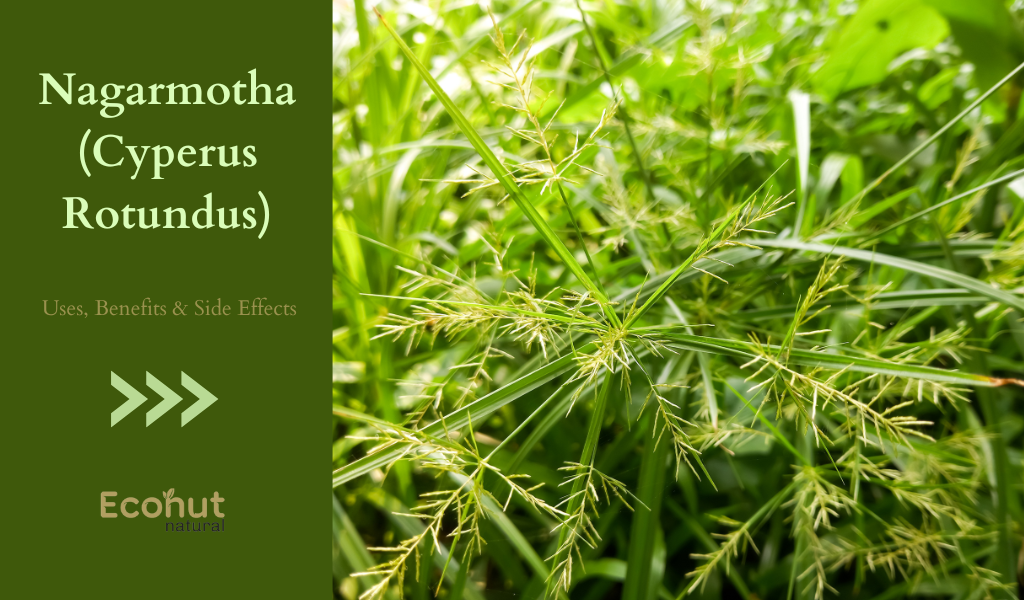Nagarmotha (Cyperus Rotundus) is also referred to as “nut grass.” It is typically used to produce incense sticks, fragrances, and culinary spices because to its distinct scent. When consumed in the prescribed dosage, the Deepan and Pachan qualities of nagamotha are said to aid in better digestion, according to Ayurveda.
Discription
As a perennial herb of traditional Ayurvedic heritage, nagamotha is also known by its botanical name, Cyperus rotundus. It is a member of the Cyperaceae family, which is closely related to the tiger nut, or chufa, Cyperus esculentus.
Nagamotha, regarded as one of the world’s most invasive and pestiferous plants, infests more than fifty different types of crops, earning it the moniker “the world’s worst weed.” Mostly found in gardens, lawns, fields, and waste areas throughout Africa, southern and central Europe, and southern Asia, it favors moist or well-irrigated light sandy and medium loamy soils that are neutral, alkaline, or acidic in nature.
Botanical name:
Nagarmotha: – Cyperus rotundus
Family:
Sedges
Appearance:
Nagarmotha is a fibrous-rooted colonial plant that typically reaches a height of 7–40 cm. They spread by producing fibrous roots, rhizomes, basal bulbs, and tubers. At first, these rhizomes are fleshy and white, with scaly leaves that eventually turn wiry, fibrous, and dark brown in color.
Flowers:
The stalks of flowers have a triangular cross section. The bisexual flower features a carpel with three stamina and three stigmas.
Fruit:
The fruit is an achene with three angles. A newborn plant’s root system first produces white, meaty rhizomes.
Parts Used:
Roots
Distribution:
Worldwide, nagarmotha is a weed that grows in all tropical, subtropical, and temperate climates. It is widespread in open, disturbed environments up to an altitude of roughly 1800 meters in India.
Chemical constituents:
The primary chemical constituents present in nagarmotha include monosesquiterpenes, terpenoids, flavonoids, and essential oils.
Dosage:
Powder 3-6 gm, decoction 50-100 ml in divided doses per day
Botanical description
Nagarmotha (Cyperus Rotundus) This perennial herb has a slender stem that becomes thicker at the base before suddenly constricting into a wiry rhizome that is subsolitary and triquetrous at the top. Lengthy, frequently overlapping stem of leaves Compound umbel-shaped flowers with loosely spiking clusters of three to eight spixelets. Trigonous nuts, flowers, and fruits contain seeds virtually all year long, but especially during the wet season.
Cultural Significance
Nagarmotha is also referred to as “nut grass.” It is typically used to produce incense sticks, fragrances, and culinary spices because to its distinct scent. Because of its antibacterial qualities, nagarmotha oil also offers protection against a range of bacterial and fungal illnesses.
Scientific Classification
| Kingdom | Plantae |
| Subkingdom | Tracheobionta |
| Super division | Spermatophyta |
| Division | Magnoliophyta |
| Class | Liliopsida |
| Subclass | Commelinidae |
| Order | Poales (Cyperales) |
| Family | Cyperacae |
| Genus | Cyperus |
| Species | Rotundus |
Other Language Names of Nagarmotha (Cyperus Rotundus)
Sanskrit name – Krodeshta,Hima
English name – Nut grass, Nutsedge,Java grass
Hindi name – Nagarmotha
Latine name – Cyperus rotundus
Telugu name – Tunga Mustalu
Tamil name – Muthakach
India name – Nagarmotha
Kannada name – Tunge Gadde
Nagarmotha (Cyperus Rotundus) Uses
- Powder
- Paste
- Tablet
- Decoction
- Pill
- Whole plant extract
- Root extracts oil
- Poultice2
Nagarmotha (Cyperus Rotundus) Benefits
Promotes Digestion:
With its exceptional digestive and carminative qualities, nagarmotha offers a complete remedy for all digestive problems. The anti-flatulent characteristic lessens gas production in the digestive tract, which lessens bloating, constipation, abdominal distension, and flatulence. The herb’s antacid qualities help treat gastritis, indigestion, ulcers, and improve the body’s absorption of nutrients by preventing the stomach from producing too much acid.
Indigestion:
Indigestion is better managed by nagarmotha. Indigestion, as defined by Ayurveda, is the result of an unfinished digestive process. Agnimandya, or exacerbated Kapha, is the primary cause of dyspepsia. Eating Nagarmotha facilitates easy digestion of food and helps to promote Agni. Its Deepan and Pachan qualities, respectively, are the cause of this.
Improves Lactation:
Daily use of this herb or any of its formulations helps to promote lactation and the quality of breast milk by increasing the production of prolactin and corticoids, which in turn helps to generate breast milk. With breast milk being the best source of nutrition and immune system building agents, this is particularly advantageous for the younger children.
Uses of Nagarmotha for Hair:
When it comes to treating hair issues like dandruff and the hair loss that follows, nagamotha powder works incredibly well. It treats dandruff, dry scalp, and hair loss by balancing the Pitta and Kapha doshas. Because of its antifungal and antibacterial qualities, it also helps eradicate lice infestations and treats ringworm and psoriasis of the scalp. Additionally, it helps to smooth and shine hair and fixes split ends.
Abdominal pain:
Relief from gas or flatulence-related abdominal pain is provided by nagarmotha. An imbalance between the Vata and Pitta doshas is the cause of flatulence. Digestion is hampered by low Pitta dosha and aggravated Vata dosha, which lower digestive fire. Pain in the abdomen is a result of poor digestion. Due to its Deepan (appetiser) and Pachan (digestive) qualities, nagarmotha aids in enhancing digestive fire and repairing digestion.
Nagarmotha to treat skin issues:
Nagarmotha is an excellent remedy for skin issues. It contains a multitude of skin-beneficial ingredients. It is possible to prevent infections and treat dry, itchy skin by applying a mixture of powdered Nagarmotha root and coconut oil to your skin. It also helps to keep skin clear.
Combats Respiratory Problems:
Nagarmotha, endowed with potent anti-inflammatory, antibacterial, and anti-asthmatic qualities, is a widely recognized traditional treatment for a variety of respiratory ailments. It is often used to treat symptoms of the flu, sore throat, cough, and common cold. Additionally, it thins and releases catarrh particles from the nasal and chest cavities, which facilitates easier breathing and aids in the body’s mucus removal.
Also Read: Bibhitaki (Terminalia bellirica): Baheda Benefits, Properties and Side Effects
Side Effects of Nagarmotha (Cyperus Rotundus)
Produces Skin Irritation:
Itching and dryness are possible side effects of nagamotha, particularly in those with sensitive skin. It is advised to combine Nagarmotha powder or oil with carrier oils, such as coconut oil, before using it topically to reduce this danger.
Constipation:
According to Ayurveda, consuming too much Nagarmotha can make the Vata dosha in the body worse, which might cause constipation.
Avoid During Pregnancy and Breastfeeding:
Scientific research is insufficient to tell whether Nagarmotha is safe to use while pregnant or nursing. If you are pregnant or nursing, it is best to speak with a healthcare provider before using Nagarmotha.
Conclusion
One of the most invasive weeds known is nagamotha (C. rotundus), a perennial plant that has spread over tropical and temperate regions of the planet. The herb is referenced in the Charaka Samhita, an old text on ayurveda. The herb, sometimes called musta or musta moola churna, is used by ayurvedic doctors to cure fevers, dysmenorrhea, digestive system problems, and other illnesses. The plant is suggested for use in modern alternative medicine to treat a variety of conditions, including pain relief, muscle relaxation, fever, inflammation, nausea, and many others.
FAQS
Which Forms Does Nagarmotha Come In?
Nagarmotha can be found in the market in a variety of forms, including oil, decoction, poultice, pill, tablet, powder, and paste.
Does powdered nagarmotha aid in weight loss?
Yes, nagarmotha powder helps with weight loss by lowering Ama levels in the body, enhancing digestion, and preventing the buildup of fat.
What negative consequences might ingesting Nagarmotha cause?
If taken in extremely high doses, possible adverse effects include nausea, diarrhea, and upset stomach, as well as interactions with other medications.
Is Nagarmotha Beneficial for Urinary Issues?
Yes, Nagarmotha’s potent mutral (diuretic) feature may aid in the treatment of urinary problems’ accompanying symptoms, such as burning or painful urination, as well as any infections. It encourages the production of pee and offers immediate relief from bladder issues.
Is nagarmotha powder beneficial for skin conditions?
The most popular application for nagamotha powder is the management of different skin conditions. Because of its antifungal and antibacterial qualities, it can help treat acne, psoriasis, ringworm, and eczema. It is safe even for extremely sensitive skin, and it also lessens skin allergies. Additionally, nagarmotha powder balances skin tone.

